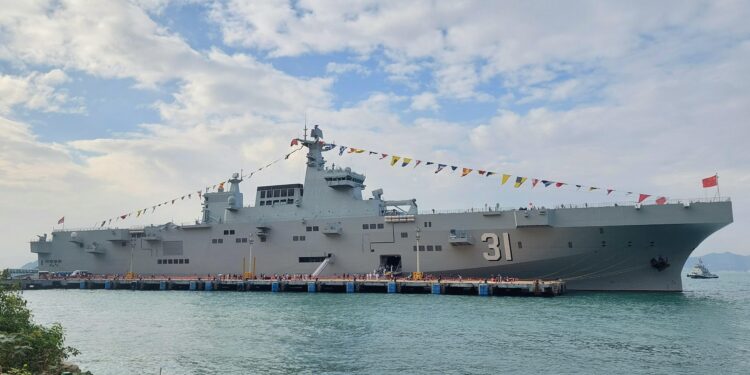Showcasing China’s Naval Might: The Hainan and Changsha Visit to Hong Kong
This week, the Chinese amphibious assault ship Hainan and the guided missile destroyer Changsha made a prominent port call in Hong Kong, signaling a robust demonstration of China’s expanding maritime power. These advanced warships not only highlight the growing sophistication of the People’s Liberation Army Navy (PLAN) but also emphasize the strategic significance of naval forces in East Asia. Their presence comes amid increasing scrutiny over naval activities in contested waters such as the South China Sea, underscoring Beijing’s intent to assert its maritime influence while fostering stronger military-community relations within Hong Kong.
The Hainan is designed primarily for amphibious operations, featuring a flight deck capable of supporting multiple helicopter sorties alongside facilities for transporting troops and heavy equipment essential for rapid deployment during landing missions. Meanwhile, Changsha boasts cutting-edge missile technology and radar systems that enhance both offensive strike capabilities and defensive measures against aerial or surface threats.
| Vessel | Classification | Main Functions |
|---|---|---|
| Hainan | Amphibious Assault Ship |
|
| Changsha | Guided Missile Destroyer |
|
Strategic Significance Behind PLAN’s Deployment to Hong Kong Waters
The docking of these formidable vessels at Hong Kong carries multifaceted strategic implications that extend beyond mere naval display. It reflects China’s ongoing efforts to consolidate its maritime dominance amid escalating regional tensions involving territorial disputes with neighboring countries around vital sea lanes.
This deployment serves dual purposes: projecting hard military power while simultaneously engaging in soft diplomacy by opening up these ships for public tours and joint exercises with local forces. Such initiatives aim to cultivate goodwill domestically while sending clear signals internationally about China’s readiness to defend its interests.
- Evolving Regional Security Landscape: Heightened alertness among Southeast Asian nations due to increased PLA Navy activity.
- Cruise Routes & Trade Security: Securing critical shipping corridors that facilitate trillions worth of global trade annually.
- Narrative Control: Reinforcing national pride through visible demonstrations of technological advancement and military preparedness.
- Synchronized Training Exercises: Improving tactical coordination across different fleets enhances collective readiness against common threats or emergencies.
- Tactical Intelligence Exchange: Sharing real-time data boosts situational awareness crucial for de-escalation efforts.
- < b >Maritime Emergency Response :& nbsp ; Strengthening capabilities related to disaster relief saves lives during typhoons or oil spills.
- < b >Humanitarian Missions :& nbsp ; Expanding cooperation beyond combat roles fosters trust among regional actors .
< / ul >
< p >According to recent reports , over $5 trillion worth of goods transit annually through South China Sea shipping lanes , making stability here vital not just regionally but globally . Establishing transparent communication channels between navies could mitigate misunderstandings that might otherwise escalate into conflict .< / p >
< h2 id=“conclusion-reflections-on-the-plan-visit” >Conclusion: Navigating Complex Maritime Realities Through Strategic Presence< / h2 >
< p >The high-profile visit by China’s amphibious assault ship Hainan alongside destroyer Changsha underscores an evolving chapter in Asia-Pacific naval affairs . Beyond showcasing formidable hardware , it represents Beijing’s nuanced approach combining hard power projection with diplomatic engagement aimed at reinforcing both domestic legitimacy & international posture . As geopolitical tensions persist around contested waters , such deployments will remain pivotal indicators reflecting shifts within regional security architectures . For observers worldwide , this event highlights how modern navies serve dual roles —as instruments safeguarding sovereignty & platforms fostering multilateral cooperation essential for peacekeeping amidst uncertainty.< / p >
| Name & Type | Main Attributes | Tactical Role |
|---|---|---|
| Hainan (Amphibious Assault)(Landing Helicopter Dock)(LHD) | Large troop capacity Flight deck supporting multiple helicopters Heavy equipment transport capability | Rapid force projection via beach landings Support air assault operations |
| Changsha (Guided Missile Destroyer) (Type 052D Class) (Multi-role Surface Combatant) |
Advanced phased-array radar systems Long-range surface-to-air missiles (SAMs) Anti-submarine warfare sensors & torpedoes Electronic warfare suites | Air defense umbrella provider, Surface strike platform, Fleet escort duties. |
Bolstering Regional Naval Cooperation Amid South China Sea Challenges
The arrival of Hainan and Changsha also symbolizes an effort by Beijing to deepen cooperative security frameworks within one of Asia’s most geopolitically sensitive zones—the South China Sea. This region remains fraught with overlapping sovereignty claims from several nations including Vietnam, Philippines, Malaysia, Brunei, Taiwan—and increasingly contested by external powers monitoring freedom-of-navigation rights.
A key component behind this visit involves enhancing interoperability between navies through joint drills focused on crisis response scenarios such as search-and-rescue missions or humanitarian aid delivery following natural disasters—areas where multilateral coordination can reduce risks despite political frictions.














Italy to Deport Egyptian Imam After Controversial Comments at Pro-Palestine Rally